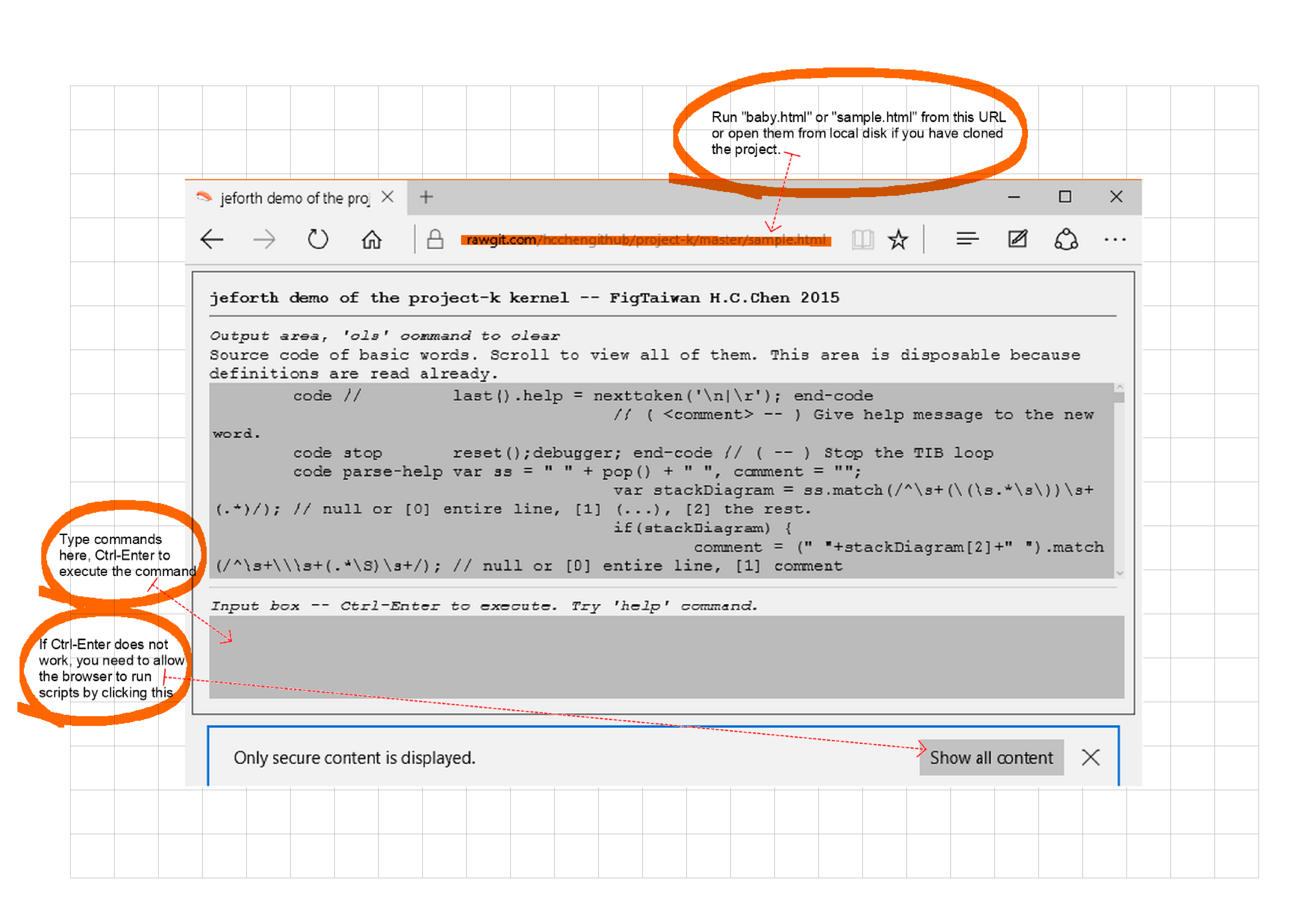A FORTH programming language kernel
en
jeForth was first invented by Yap and Sam Suan Chen, FigTaiwan during end of 2011. It’s a very simple way to develop your own FORTH system anywhere JavaScript is available – Web page, HTA, Node.js, Node-Webkit or NW.js, and Windows DOS box, to name only those have tested so far.
This project has only one file, projectk.js, which reduces the original jeForth
down to having only two FORTH
words, “code” and “end-code”, and a few other JavaScript
global functions like push(), pop(), tos(), tick(), and last(), etc.
The benefit is that, having JavaScript host behind, we don’t need to build
an entire FORTH system to do just a little thing in FORTH way.
New! Python version is now available too. Thanks to the jupyter notebook and the binder technology we can use project-k online to start building your own system. Play it now if you have 15 minutes: https://mybinder.org/v2/gh/hcchengithub/project-k/master?filepath=Play%20with%20the%20FORTH%20kernel%20on%20jupyter%20notebook.ipynb
See also https://github.com/hcchengithub/peforth which is a developped python FORTH top on project-k.
play now
Click one of the following links to play demo directly from the GitHub repository,
baby.html
sample.html
- sample.html : http://hcchengithub.github.io/project-k/sample.html
Try one or the other, cdn may be necessary at where you are. Demo baby.html is very simple and its FORTH source code area is very short too, so please try to read them; while sample.html has most FORTH words already. Try ‘words’ command and ‘see’ their definitions. Read messages on the screen and try what it says. As shown below,

Microsoft Windows’ browser (IE or Edge) may block the demo program, as shown in the above screen capture, you need to enable something. Better use Google Chrome to avoid the little obstacle.
hands on
projectk.js is the only file in this project. The below two lines generate a FORTH Virtual Machine on your web page in HTML:
<script src="http://hcchengithub.github.io/project-k/projectk.js"></script>
<script> vm = new jeForth(); </script>
Now we have an object ‘vm’ which is the FORTH virtual machine that has only two FORTH words ‘coce’ and ‘end-code’. Use the two words to create your own entire FORTH system then.
tutorials and documents
Find tutorials and documents in the wiki.
quick reference
On variant applications, how to get the project-k VM up and running,
a. For HTML and HTA:
<script src="http://hcchengithub.github.io/project-k/projectk.js"></script>
<script> vm = new jeForth(); </script>
b. For Node.js and Node-webkit:
jeForth = require("./projectk.js").jeForth;
vm = new jeForth();
c. For WSH cscript.exe:
eval(readTextFile(".\\projectk.js"));
vm = new jeForth();
/* readTextFile() is not cscript.exe built-in, you need to write it */
real thing
jeforth.3we is this project’s predecessor that has completely been developed. You can use it to do real things. The bast way to learn FORTH is to create your own FORTH. So I rejuvenate jeforth.3we back to it’s kernel, the projectk.js source code, for people to develop their own FORTH system from a higher starting point.
participation
Any suggestion or question, use the ‘issues’ and ‘wiki’ on this GitHub repository, raise them to the FigTaiwan forum or email me.
tw
整理 FigTaiwan 用 JavaScript 寫成的 Forth VM, 只專注在 kernel 使它能適用所有的場合(HTML, Node.js, Node-webkit, WSH, HTA)。 這個目的迫使 kernel 必須精簡、易懂。說明稿直接放在 GitHub > project-k > Wiki, 透過 GitHub > project-k > issues 追蹤討論單項問題。
Happy programming !
FigTaiwan H.C. Chen
hcchen5600@gmail.com